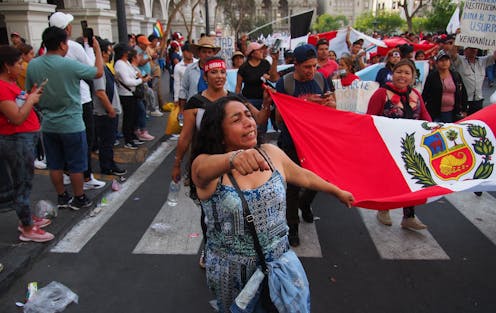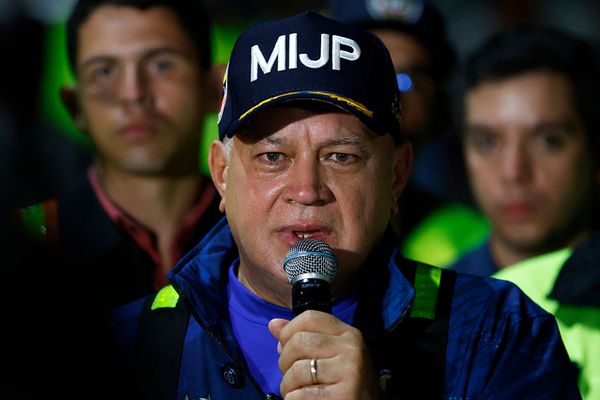
Peru is in the midst of a political and civil crisis. Weeks of protest have culminated in thousands descending on the capital amid violent clashes and running battles with police.
Triggered by the recent removal from power of former leader Pedro Castillo, the protests have exposed deep divisions within the country and are being encouraged by a confluence of internal factors and external agitators.
The Conversation asked Eduardo Gamarra, an expert on Latin American politics at Florida International University, to explain the wider context of the protests and what could happen next.
What sparked the protests in Peru?
The immediate trigger was events on Dec. 7, 2022, that saw now-ousted President Castillo embark on what has been described as an attempted coup. But whether it was a “coup” is subject to debate. Castillo’s supporters say he was trying to head off a different type of coup, one instigated by Congress.
Castillo – a leftist, Indigenous former teacher from the country’s south – tried to shut down a Congress intent on impeaching him over corruption claims and accusations of treason. He called on the military to support him, and his intention was to form a constituent assembly to reform the country’s constitution. But his plan didn’t work. The military rejected Castillo’s ploy, and Congress refused to be dissolved and went ahead with its impeachment vote, removing him from power.
The events of that day set off the protests that have built in momentum over the subsequent weeks.
But while the events of Dec. 7 were the immediate trigger, it is important to understand that this crisis was long in the making.
What is the wider background of the political crisis?
The crisis is rooted in the nature of Peru’s political system. In part by design, the country’s constitution, which was adopted in 1993 but amended a dozen times since, creates ambiguity in who has the greater power – the president or Congress. Constitutionally, Congress is given enormous scope to limit executive power, including removal through impeachment. The idea was to serve as a bulwark against the excesses of authoritarian-minded presidents. But in reality, it encourages instability and a weak executive. The constitution is so ambiguously written that it also gives wiggle room for presidents who want to shut down Congress, as Castillo unsuccessfully tried to do.
Meanwhile, Peru has seen a dismantling of its old, established political party system. Once-powerful parties no longer exist or struggle to get support. As a result, the country’s party system has fractured – more than a dozen parties are represented in Congress, which makes it hard for any one leader or party to achieve a majority. In short, it makes it hard to govern when you have no legislative base to do so. For example, Castillo had the support of only 15 members of his own party in the 130-seat assembly.
On top of all that, the country is deeply polarized and divided along a number of different lines: ethnic, racial, economic and – as the protests have fully shown – regional.
Who is protesting and just how large is the movement?
First off, they are Castillo supporters. While he had no real power base in the country’s capital, Lima, Castillo – as the first real rural president the country has had – had significant support in the south.
The protests have been concentrated around the city of Puno, but support has come from the whole high Andes of southern Peru.
The area is predominantly Quechua and Aymara – the two major Indigenous groups in the Peruvian south. Peruvian Quechua and Aymara are “first cousins” to the same groups over the border in Bolivia. And this is important in the context of the current protests.
Evo Morales, the former president of Bolivia, has long talked about “runasur” – the concept of uniting Indigenous people across the Andes region.
Morales has been blamed by the Peruvian government for stirring up the protests – indeed he has now been banned from entering Peru. No doubt, Bolivian allies have been in Peru’s south mobilizing the movement, and some have been arrested.
But what you are really seeing is a “Bolivia-ization” of the protest movement in Peru. The tactics of the protest movement in Peru are similar to those of the forces behind the pro-Morales unrest in Bolivia of both 2003 and 2019 – the road blockades, the violence against police that has seen at least one officer killed and others injured. That in no way excuses the the brutal response by police, which has seen more than 50 demonstrators killed.
But even in the treatment of these deaths you see echoes of Bolivia. Just as in Bolivia, protesters are framing the anti-demonstration violence by authorities as a “genocide” – claiming that police are targeting Indigenous groups because of who they are.
In my view, that is incorrect. The police are obviously using excessive force, but the officers involved are themselves, in many cases, Indigenous.
What are the demands of protesters?
Primarily they are trying to force the government in Lima to agree to a constituent assembly to devise a new constitution; what that new constitution would look like is a secondary concern.
They are also trying to force the resignation of the woman brought in to replace Castillo, Dina Boluarte. I believe that is an achievable goal. Boluarte suffers from many of the same problems as her predecessor – she has little real support in Congress and no support in the streets. On top of that, having not been elected into office, she lacks democratic legitimacy in the eyes of many.
President Boluarte has said she will not resign. She is studying the possibility of calling early elections, but there is little chance of her agreeing to a constituent assembly at this time.
As to how this movement will advance the concept of a regional runasur, that is difficult to judge. Certainly the Peruvian situation is no longer just a Peruvian issue – it involves Bolivia, and the protest has vocal support from the Latin American left.
But it is tough to say how well supported the protest movement is within Peru, given how divided the country is. It certainly hasn’t got the backing of urban areas in the north of the country.
Nonetheless, it has shown the mobilizing capacity of Indigenous people – just as in Bolivia. And the goal of many is not to win support, but to demonstrate this strength.
Will Peru’s protest follow the course of past unrest in the region?
That is anybody’s guess. If you follow the logic of the Bolivian comparison you will see increasing turmoil, and potentially more violence – such as that country experienced in 2003 and 2019. If that is the case, returning Peru to the old style Lima-centric politics will be difficult. The deep divides in Peruvian society and the fracturing of its political system make it hard to envision a political force emerging that can deal with all of these issues. And that is what makes the current situation so difficult to resolve.
Meanwhile, comparisons to the protests in Peru that ousted Alberto Fujimori in 2000 may be misplaced. Those protests took place in a very different context – Fujimori was perceived by then as a dictator who had plundered the country of billions of dollars. It was an uprising to remove a dictator.
What you have now is an unpopular ex-president in jail and an unpopular president with contested claims to legitimacy in power. It is very different context. It isn’t a transition from authoritarianism to democracy; it is protest resulting from an inefficient democratic system at a time of a deeply divided country.
As an academic and as director of a university research center, I've received funding from foundations, US government agencies, and multilateral institutions.
This article was originally published on The Conversation. Read the original article.







